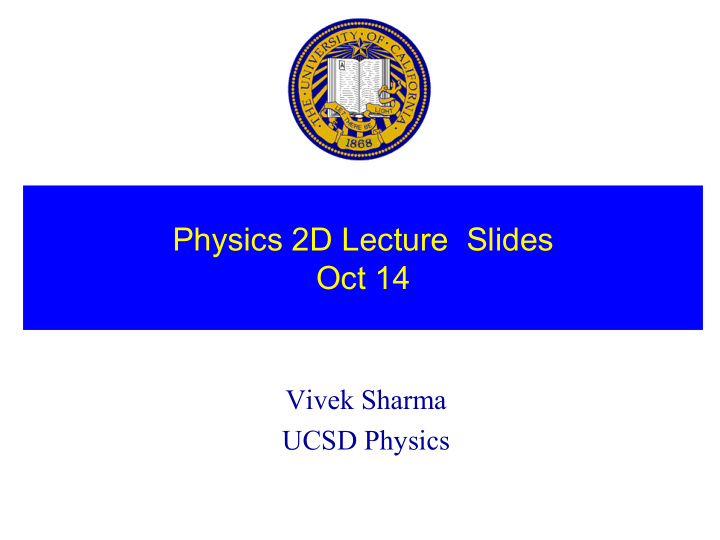



Physics 2D Lecture Slides Oct 14 Vivek Sharma UCSD Physics
Ch 2 : Quantum Theory Of Light • What is the nature of light ? – When it propagates ? – When it interacts with Matter? • What is Nature of Matter ? – When it interacts with light ? – As it propagates ? • Revolution in Scientific Thought – Like a firestorm of new ideas (every body goes nuts!..not like Evolution) • Old concepts violently demolished , new ideas born – Interplay of experimental findings & scientific reason • One such revolution happened at the turn of 20 th Century – Led to the birth of Quantum Theory & Modern Physics
Blindmen & an Elephant touched the trunk of the elephant, said elephant was like a branch of a tree . touched the tail of the elephant, said elephant was like a snake. touched an ear. He said elephant was a huge fan. felt a leg of the elephant., elephant was like a pillar . touched the side of the elephant, said the elephant was like a wall The Physicist: Gentlemen, all five of you have touched only one part of the Elephant…...elephant is all of above LIKEWISE WITH LIGHT !
Classical Picture of Light : Maxwell’s Equations • Maxwell’s Equations: permeability permittivity
Hertz & Experimental Demo of Light as EM Wave
Properties of EM Waves: Maxwell’s Equations Energy Flow in EM W aves : � � � 1 × Poy nting Vector S = ( E B ) µ 0 � � Power inciden t on 1 ( ) = = − ω 2 S A . AE B Sin ( kx t ) µ 0 0 an area A 0 1 2 Intensity of Radiation = I c E µ 0 2 0 Larger t he amplitude of Oscillation More intense is the radiation
Disasters in Classical Physics (1899-1922) • Disaster � Experimental observation that could not be explained by Classical theory (Phys 2A, 2B, 2C) – Disaster # 1 : Nature of Blackbody Radiation from your BBQ grill – Disaster # 2: Photo Electric Effect – Disaster # 3: Scattering light off electrons (Compton Effect) • Resolution of Experimental Observation will require radical changes in how we think about nature – � QUANTUM MECHANICS • The Art of Conversation with Subatomic Particles
Nature of Radiation: An Expt with BBQ Grill Question : Distribution of Intensity of EM radiation Vs T & λ Grill • Radiator (grill) at some temp T • Emits variety of wavelengths • Some with more intensity than others • EM waves of diff. λ bend differently within prism • Eventually recorded by a detector (eye) • Map out emitted Power / area Vs λ Notice shape of each curve and Intensity R( λ ) learn from it Prism separates Out different λ Detector
Radiation from A Blackbody
(a) Intensity of Radiation I = ∫ λ λ ∝ 4 R ( ) d T = σ 4 I T (Area under curve) Stephan-Boltzmann Constant σ = 5.67 10 -8 W / m 2 K 4 (b) Higher the temperature of BBQ Lower is the λ of PEAK intensity λ ΜΑ X ∝ 1 / Τ Wein’s Law λ MAX T = const = 2.898 10 -3 mK As a body gets hotter it gets more RED then White Reason for different shape of R( λ ) Vs λ for different temperature? Can one explain in on basis of Classical Physics (2A,2B,2C) ??
Blackbody Radiator: An Idealization Classical Analysis: T • Box is filled with EM standing waves • Radiation reflected back-and-forth between walls • Radiation in thermal equilibrium with walls of Box • How may waves of wavelength λ can fit inside the box ? Blackbody Absorbs everything Reflects nothing All light entering opening gets absorbed (ultimately) by the cavity wall Cavity in equilibrium T w.r.t. surrounding. So it radiates everything It absorbs Emerging radiation is a sample of radiation inside box at temp T less Even more more Predict nature of radiation inside Box ?
The Beginning of The End ! How BBQ Broke Physics Classical Calculati on λ λ λ # of standing waves between Waveleng ths and +d a re π 8 V λ λ • λ 3 N( )d = d ; V = Volume of box = L λ 4 Each standing w ave c on t ributes energy E = k T to radiation in Box λ × Energy density u( ) = [# of standing waves/volume] Energy/Standing Wave π π 8 V 1 8 × × = kT = kT λ λ 4 4 V π π c c 8 2 c λ λ = R ad iancy R( ) = u( ) = kT kT λ λ 4 4 4 4 λ Radiancy is Radiation intensity per unit interval: Lets plot it Prediction : as λ � 0 (high frequency) ⇒ R( λ ) � Infinity ! Oops !
Ultra Violet (Frequency) Catastrophe OOPS ! Radiancy R( λ ) Classical Theory Disaster # 1 Experimental Data
Disaster # 2 : Photo-Electric Effect Light of intensity I, wavelength λ and frequency ν incident on a photo-cathode Can tune I, f, λ i Measure characteristics of current in the circuit as a fn of I, f, λ
Recommend
More recommend